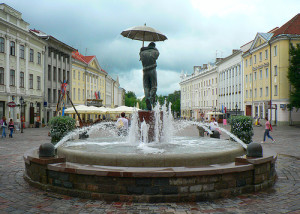 At first glance, the Baltic countries appear to be an extremely sought as destination for holidays and travel. I said well, at first, only. For example, Estonia is a country with a culture, language and civilization unique and original, and with a natural full of sights value.
At first glance, the Baltic countries appear to be an extremely sought as destination for holidays and travel. I said well, at first, only. For example, Estonia is a country with a culture, language and civilization unique and original, and with a natural full of sights value.
One of these attractions tempting enough to merit a visit, is, for example Tartu city. I know that few have heard of it, and even fewer have visited, but the oldest city in Estonia has much to offer to any person thirsty for travel and beauty discoverer.
One of the most beautiful student capitals of Europe
Considered by many tourists and residents also as the spiritual capital of Estonia, Tartu is among others, the country’s second largest city after the capital Tallinn. With its numerous wooden buildings, so characteristic and its charming streets, looking 19th century, Tartu quiet reigns on the riverbanks Emajogi.
Tartu became the largest university of Estonia, and students make up nearly a fifth of its population of over 100,000 inhabitants. The fact that it is a high-caliber university adds an infusion of joy and youth in its tourism attributes. Also known as the Dorpat and Yuriev. In the past, Tartu was one of the famous cities that were part of the Hanseatic League, and it was first mentioned in documents in 1030, and is also the oldest city in Estonia.It is located at a distance of 185 km southeast of Tallinn, and the river Emajogi runs through it length of 10 km linking the city to two of the largest lakes of Estonia.
Being a university town, Tartu is extremely cosmopolitan and English language is spoken everywhere. Obviously older people only know Estonian and Russian, but nearly all young people know English. The central square, named by locals as Raekoja Flat, is really the alive and vibrant heart of this place, the more that here are all the offices and places for the tourists where they can get information in Tartu.
This city has actually the most important and interesting museums in Estonia. Tartu hostes extraordinarily important archives, local folklore collections and treasures of literature and Estonian language. Tartu Art Museum, located in the historic center, also hostes valuable collections including many distinguished masterpieces of Russian and Estonian painting artists.
Not just the museums and cathedrals have brought fame to this city and its unusual beaches located on the north of the river meander Emajogi as well. Apart from some gorgeous beach places, here the authorities have arranged several basketball courts and bars.
Another attraction of the place is the beautiful Botanical Garden of Tartu, founded since the 19th century and currently holds impressive collections of plants, containing over 7,000 plants, trees and shrubs from various parts of the world. Here you can admire over 200 varieties of roses, and a giant greenhouse, 22 meters high which hostes an amazing variety of tropical plants.
The most important and the oldest place of learning in the city is University of St. John, which was founded in 1632 by Gustaf Adolf the second, then king of Sweden. Science and knowledge have always characterized the spirit of Estonians, so the greatest scholars and researchers have studied in ülikool University of Tartu, founded in 1803.
KGB Museum and District of soups and broths
Another major tourist attraction of the city is the huge and imposing Toomemägi Cathedral, which dominates the old center, being built on a hill in order to enhance the appearance and splendor. Other memorable places are the famous District of soups and broths, in which each street is named with a recipe for soup, a former military airport in the Soviet period, Raad and Barclay parks, red brick Roman Catholic Church, built in 1899 and Orthodox Churches St. Alexander and Uspenski, build in the popular architectural style of Russian churches.
But you must not leave Tartu without visiting the KGB City Museum. Located in Riia Street, number 15, was a bleak building and feared by all Estonians who lived in that period in which their country was incorporated into the USSR. Named by locals Grey building, the museum today was the headquarters of the KGB in Estonia. Visiting the museum shows clearly how were treated and interrogated prisoners and suspects.
Here is also a gallery dedicated to fighters of the Estonian resistance against communism and Sovietization of the country, irregular fighters grouped in the Forest Brothers organization, the organization was faced directly with the staff in the past and feared KGB agents.
Other important objectives are Vanemuine Theatre, Catherine House, and especially the Gunpowder Cellar, which is nothing but the old military arsenal of the former city of Tartu, is dug into a hill at the end of 1776. Today in the Gunpowder Cellar is arranged a cozy bar.National Court was originally built in 1763 as a barrack, then operating a hospital here. But in 1993, this sumptuous historical building works in the role of Supreme Judicial Court’s in the country.
And there are many other wonderful places and buildings in Tartu, you only have to have time and curiosity to look.
In the city there are numerous artistic and cultural events, outdoor theater, concerts and themed festivals are held here throughout the year. Summer Theatre has performances every day throughout the summer calendar, days of the Hanseatic League is a wonderful medieval festival that fits perfectly in a city with about 100,000 inhabitants, but with over 20 museums.
Tartu is a city for everyone, intellectuals, young students, families, the elderly, romantic couples, everyone will feel great here. Locals say that Tartu always gives you a reason to return here. Whether to meet up with Ghost Town, another tourist attraction!


